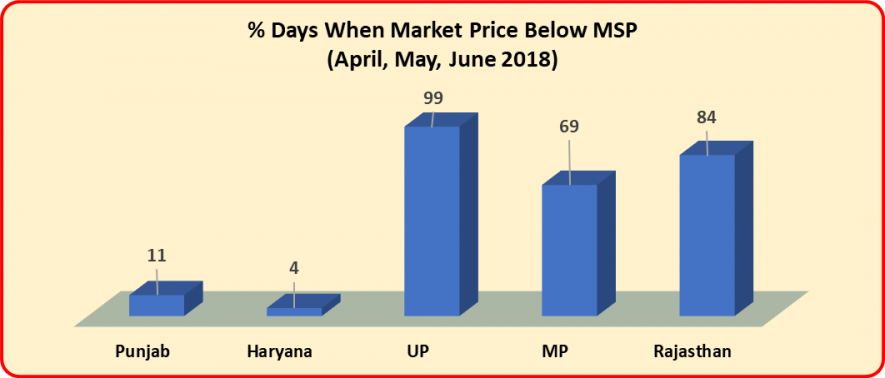Why MSP Is Not Satisfying Farmers

Just over 12% of wheat farmers in the country are able to sell their produce to government agencies and in most states, prices in mandis (wholesale markets) remain below MSP (minimum support price) for most of the season. These two crucial factors – ignored by the government – are causing the whole MSP policy to leave farmers dissatisfied and in distress. This is in addition to the fact that the government is in any case fixing the MSP at levels which are much below the total cost+50% that farmers have been demanding, as reported earlier by Newsclick.

As the above graphic shows, a majority of farmers in only Punjab and Haryana are able to sell their wheat to government procurement agencies. These two states together make up only about 7% of the country’s wheat farmers. In Uttar Pradesh, which has an estimated 1.5 crore wheat farmers, the largest number in India, only about 11 lakh farmers (7%) could sell their produce to government agencies. In Rajasthan, the share was even lower at 4% while in MP, the share was 22%. These five states together account for 77% of wheat growers in India. These data have been computed from the Price Policy Report for Rabi 2019-20 published by the Commission on Agricultural Costs & Prices, under the Agriculture Ministry, and the Agricultural Census data on operational holdings 2010-11 and 2015-16.
But this is not all. The Rabi Price Policy Report also reveals that in most states, barring Punjab and Haryana, wheat was sold at below the fixed MSP for most of this year’s marketing season spanning the months of April, May and June when the wheat crop is brought to markets by farmers.
Shockingly, in UP and Rajasthan, almost the whole three-month long season went by with wheat prices quoted at below MSP while in MP over two thirds of the season saw daily prices below the benchmark. Only in Punjab and Haryana did the bulk of the season pass with farmers able to get MSP level prices for wheat.

If this is the state of affairs, it is small wonder that farmers are in turmoil across the country. Like many of Prime Minister Narendra Modi’s schemes, this policy too is turning out to be mostly confined to paper. And, that means that farmers’ distress is not at all getting assuaged by policy announcements. The situation is worse for other rabi crops like barley, mustard, safflower etc.
There are several reflections of this continuing distress and the failure of the Modi government to assuage this: a joint platform of over 200 farmers’ and other people’s organisations have given a call for a long march to Delhi in November this year. Only a few days back, farmers from several North Indian states tried to march to Delhi but were stopped and brutalised at the orders of the central government at the Delhi-UP border. Farmers’ suicides continue unabated despite a good crop this year.
The failures of the Modi government on the agrarian front will have repercussions for the forthcoming Assembly election polls which will be held in MP and Rajasthan too. Farmers’ mounting anger is already reflecting in opinion polls which show a tight race or even a loss for BJP in these polls. And it will also be an issue in the general elections next year.
Get the latest reports & analysis with people's perspective on Protests, movements & deep analytical videos, discussions of the current affairs in your Telegram app. Subscribe to NewsClick's Telegram channel & get Real-Time updates on stories, as they get published on our website.
























